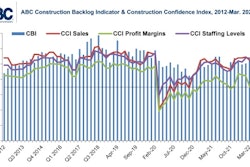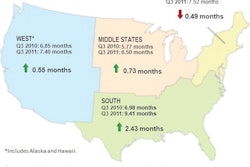This is about the time of year when many pavement maintenance contractors begin focusing on work that they will push into the next year. Building your backlog of work is not only smart to do but can provide you with a tremendous morale boost for your employees, not to mention some early spring revenues.
Now, building a backlog of work is not only for the seasonal contractor, but for any contractor looking to strengthen next year’s work schedule. Consider a few techniques that may assist you making the most of building your backlog.
1. Be Sensitive to Customer’s End-of-Year Budget Needs
If you do commercial or public work you should be aware that many organizations live and die by their annual budgets. So, it is critical that you are prepared for those organizations that need to get some end of the year work either started or completed. For some organizations, it is truly “use it or lose it.” Therefore, you may want to consider developing your proposals to allow for year end work, even if just to get the money process moving, allowing the customer to access funds that was intended for such use.
2. “Value-Add” on End-of-Year Budget Needs
As an extension of the first technique, be alert to add other related work that would enhance the scheduled work. What is interesting in most organizations is that there is often budget monies available in other business areas that is not accessed. Your contact may be able to find another five, twenty, even fifty thousand dollars that other areas will not be using by year end and convert that budgeted amount into providing you with more work.
3. Break Your Proposal into Incremental Segments
Preparing a one hundred and fifty thousand dollar contract into three fifty thousand dollar segments is easy to do and allows you to perhaps start one or two segments in the fall and continue the completion into the new budget year or when spring arrives. For some organizations, you may be doing the buyer a favor by securing the budgeted need this year, offering to carrying budgeted dollars into the next year. Some customers will actually increase budget needs with such flexibility provided by a contractor.
4. Commit “Next Year’s” Work to Schedule
With work that will be completed “next year” be sure to clearly schedule the work in the fall. This is a clear sign to the customer that you are committing their work to your calendar. For some customers you will be giving them first choice of getting work completed. It also encourages your own workers that you have start-up work in the new-year.
5. Provide Incentives to Schedule Work Next Year
For the customer who is not demanding work completion “this year” you might create an incentive to schedule work in the new-year. The incentive might be to offer the customer a 5% - 15% discount on work, holding material costs to the proposed for three to six months, or giving the customer first choice of when to schedule the work. Don’t overlook offering an incentive; this is a small thing to do that can provide the customer with a feeling of getting something that others do not get.
6. Propose a 36-Month Pavement Maintenance Program (PMP)
In your effort to move some customer’s work to the new-year, make a proposal of maintaining their property over the next three years. Show them how you can build their current needs into a program where you will care for their pavement maintenance needs making their budget go further. Talk to them in terms of the “return on investment” they will enjoy by reducing their actual dollars spent as more consistent touches are made quarterly over three years. Compare what happens when pavement needs wait to the emergency stage versus making a consistent pavement maintenance effort that allows smart planning and less unplanned expenditures.
7. Create a Specialized Marketing Piece to Support Backlog Effort
With such an added tool to use go out to even existing customers to inform them of your offering the “36 Month PMP”. Such a piece of marketing is a great excuse to even call on past accounts that you have not completed work for in years, perhaps some whom you have even loss work. Don’t let your pride get in the way to inviting your customers, past or present, from being tempted to sign on with you and start building that backlog of work.
Can an idea like the “36 Month PMP” be presented at any time of the year? Of course! However, keep in mind that many contractors wear down over the course of the year. For the seasonal pavement maintenance contractor, they are hitting it very hard right up to mid to late November, maybe the first week or so of December. However, going to some of those same end-of-the-year clients with a strategy that says, “Hey, let’s do some now and schedule the rest in the early spring!” may be just the ticket to build up your backlog.
Give the seven techniques presented above a go this fall. Don’t be shy and don’t hold back. Go for it and see just what backlog you have built up for the new-year. Better yet, write me about your success or share with me your stories in person at either the 2011 Pavement show in San Diego or the 2012 National Pavement Conference in Memphis.
Build that Backlog!
Brad Humphrey is President of Pinnacle Development Group, a consulting firm that specializes in the construction industry. For more information about Brad and his organization go to www.pinnacledg.com . Plan on attending one of Brad’s classes at this years Pavement West Conference in San Diego or next year’s National Pavement Conference in Memphis.



















